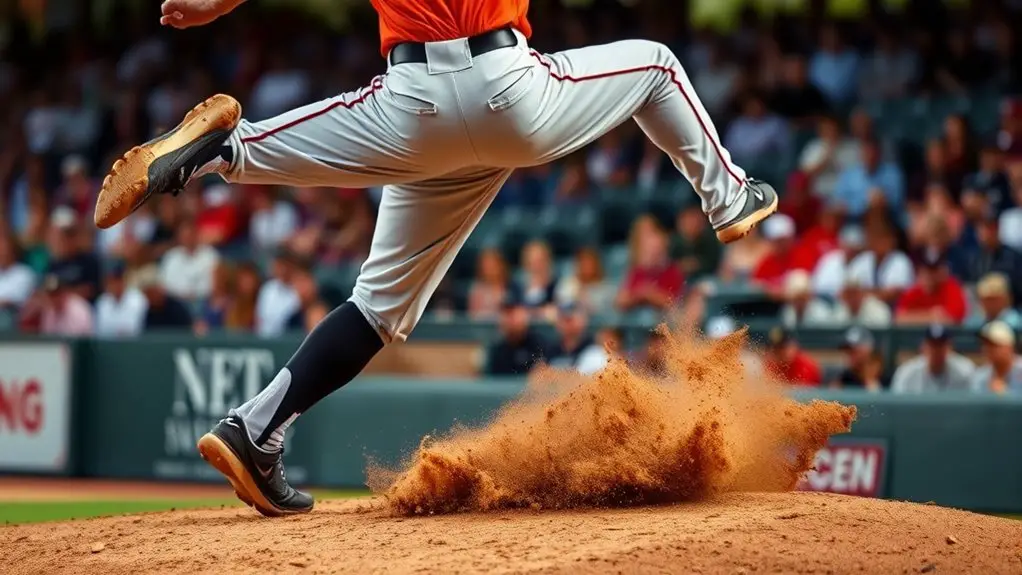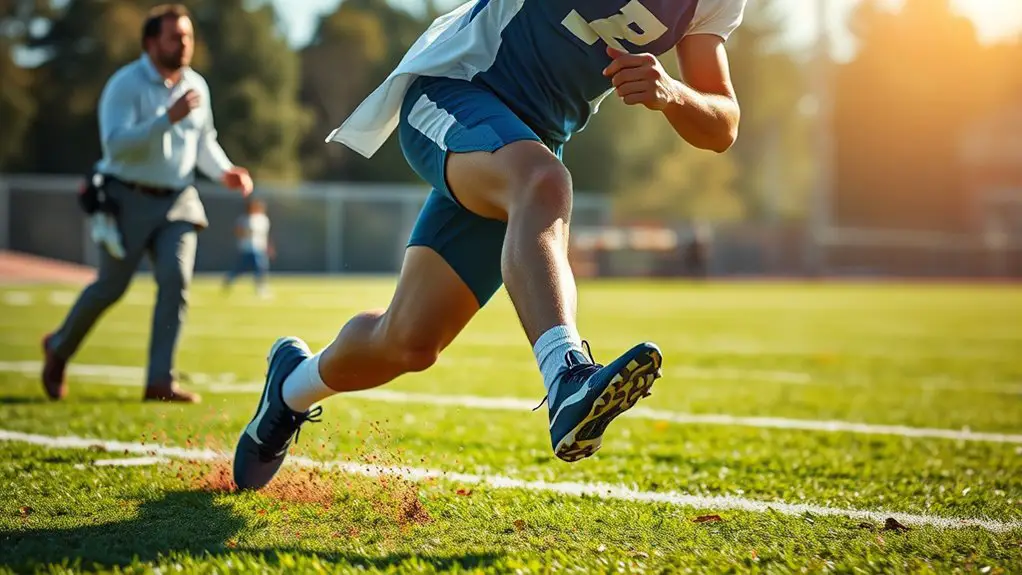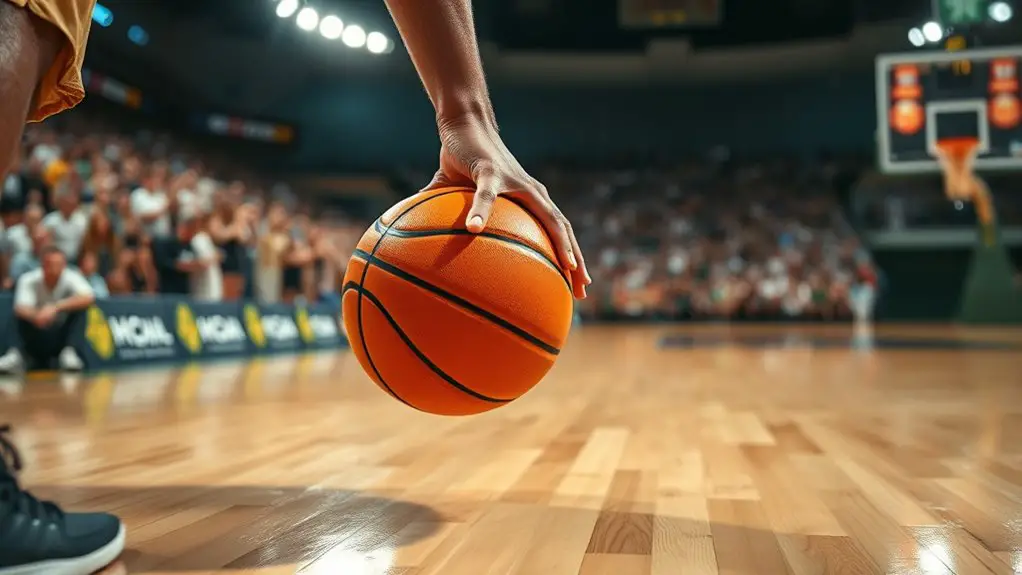Leg drive plays an essential role in powerful pitching by utilizing the strength of your lower body to boost both velocity and control in your throws. When you fully engage your legs, you create a solid foundation for balance and effective energy transfer. This dynamic leads to increased pitch speed and improved precision. By refining your leg drive mechanics and addressing common mistakes, you can enhance your performance on the mound. There's much more to explore about optimizing your technique.
Understanding Leg Drive: The Basics
When you think about pitching mechanics, leg drive often doesn't get the attention it deserves. Yet, it's one of the leg drive fundamentals that can elevate your game. Imagine harnessing the power from your legs to create more velocity and control. By focusing on your leg drive, you're tapping into a natural source of strength.
The benefits of leg drive are numerous. Not only does it help you generate speed, but it also stabilizes your body, reducing the risk of injury. When your legs engage properly, they act like a coiled spring, releasing energy as you pitch. This connection between your legs and upper body creates a seamless flow, allowing you to pitch with precision. Incorporating squats into your training routine can significantly enhance your leg drive, contributing to greater power and stability during your pitches.
The Mechanics of Leg Drive
When pitching, your lower body plays a vital role in generating power and stability. Understanding the connection in the kinetic chain can help you maximize your leg drive for better performance. Let's break down how your legs work in harmony with the rest of your body to enhance your pitch. A strong core enhances stability during the pitching motion, allowing for more efficient power transfer from your legs to your upper body.
Importance of Lower Body
The lower body plays an essential role in pitching, as it's the foundation for generating power and stability. When you harness your lower body strength, you're setting the stage for explosive movement. Your legs aren't just there for balance; they're your power source. As you push off the mound, that drive creates energy that transfers through your entire body, propelling your pitch with intensity. Engaging your hips and legs properly can elevate your performance, allowing you to throw harder and with greater accuracy. By focusing on developing lower body strength, you free yourself to pitch with confidence and release your full potential on the mound. Remember, the power of your pitch starts from the ground up!
Kinetic Chain Connection
Power in pitching comes from a seamless connection throughout the kinetic chain, where every part of your body works in harmony. When you engage your legs, you're not just pushing off the mound; you're tapping into kinetic energy that travels upward through your body. This energy transfers from your legs to your core and finally to your arm, creating impressive force generation. It's essential to maintain that fluid connection. If your leg drive is strong and synchronized with your upper body, you'll release your full potential on the mound. Remember, the freedom in your movement allows you to harness that energy effectively, leading to more powerful pitches. Embrace this connection, and let it fuel your performance.
How Leg Drive Affects Pitch Velocity
When you pitch, your leg drive plays an essential role in determining how fast the ball travels. By properly utilizing your legs, you can effectively transfer energy from your lower body to your arm, increasing pitch velocity. Understanding this connection can help you enhance your overall performance on the mound.
Mechanics of Leg Drive
Harnessing your leg drive is essential for maximizing pitch velocity. Your legs are more than just support—they're your power source. Strong leg muscles provide the necessary force to propel your body forward, translating into speed and precision. Implementing balance techniques during your wind-up and follow-through helps maintain stability, ensuring that your energy isn't wasted. As you push off the rubber, focus on engaging your quads and hamstrings, allowing them to work in tandem for explosive movement. Stay grounded while maintaining fluidity in your motion. By refining these mechanics, you'll reveal the full potential of your leg drive, leading to greater pitch velocity and ultimately, more success on the mound. Embrace this freedom, and let your legs lead the way!
Energy Transfer to Arm
Leg drive greatly influences the energy transfer to your arm during a pitch. When you harness your legs effectively, you boost energy efficiency, allowing more force to flow through your body and into your throwing arm. This means better muscle activation in your core and shoulders, resulting in increased pitch velocity. Here's a quick breakdown of how leg drive impacts your pitching:
| Aspect | Effect on Energy Transfer | Importance |
|---|---|---|
| Leg Drive Power | Increases Velocity | Essential |
| Core Stability | Supports Arm Movement | Critical |
| Timing & Coordination | Enhances Efficiency | Key to Success |
Enhancing Control Through Lower Body Engagement
Although many pitchers focus on their arm mechanics, enhancing control often starts with lower body engagement. By prioritizing lower body stability, you create a solid foundation that allows for a more consistent and powerful delivery. When your legs are properly engaged, you'll find it easier to maintain a balanced posture throughout your windup and release. This stability not only supports your arm but also helps you direct your pitches with greater precision.
Picture yourself using your legs to drive into the pitch, feeling the ground beneath you. As you engage your lower body, you'll notice a smoother transfer of energy, which translates into better control over your pitch's location and movement. Embracing this connection between your legs and your arm can lead to newfound freedom in your pitching. Additionally, focusing on functional mobility can enhance your lower body engagement and overall effectiveness. So, take a moment to focus on your lower body and watch how it transforms your control on the mound.
Common Leg Drive Mistakes to Avoid
While focusing on leg drive can greatly enhance your pitching performance, there are common mistakes that can undermine your efforts. One of the biggest leg drive pitfalls is failing to engage your lower body fully. If you rely too much on your arm, you're missing out on the power generated from your legs. Another common error is overstriding, which can lead to loss of balance and control. It's crucial to find that sweet spot in your stride length to maintain stability.
Additionally, neglecting to rotate your hips can limit your momentum and effectiveness. Make sure you're using your hips in conjunction with your legs for a powerful push. Finally, don't forget about timing; rushing your leg drive can throw off your entire motion. By being aware of these leg drive pitfalls and common errors, you'll free yourself up to pitch with greater strength and precision.
Drills to Improve Leg Drive
To enhance your leg drive in pitching, incorporating specific drills into your routine can make a significant difference. Focus on exercises that build leg strength and improve your overall stability. Start with squats and lunges; they'll help strengthen your legs and core, providing a solid foundation for your pitch.
Balance drills, like single-leg stands or wobble board exercises, can enhance your stability and coordination. These drills guarantee you're transferring power efficiently from your legs to your upper body.
Another effective drill is the wall sit, which not only builds endurance in your legs but also reinforces proper posture during your pitching motion. Additionally, prioritizing mobility and flexibility is essential to reduce injury risk and enhance your lifts.
Combine these exercises into your training regimen, and you'll notice improvements in your leg drive. Remember, a powerful pitch starts from the ground up, so invest time in developing your leg strength and balance for maximum pitching performance.
The Connection Between Leg Drive and Injury Prevention
Understanding the connection between leg drive and injury prevention is crucial for any pitcher. When you maximize your leg drive, you're consciously improving your body mechanics, which can greatly lower your injury risk. Proper leg drive stabilizes your lower body, allowing for a more balanced and powerful delivery.
Here's a quick overview of how leg drive impacts injury prevention:
| Factor | Impact on Injury Risk |
|---|---|
| Strong Leg Drive | Reduces strain on arm |
| Proper Alignment | Prevents overuse injuries |
| Balanced Mechanics | Minimizes torque |
| Controlled Movement | Limits sudden stress |
| Core Engagement | Supports overall stability |
Incorporating proper warm-ups into your routine can further enhance your leg drive and reduce the likelihood of injuries.
Analyzing Professional Pitchers' Leg Drive Techniques
When examining the leg drive techniques of professional pitchers, you'll find that each athlete brings their own unique style to the mound, yet certain fundamental principles remain consistent across the board. A solid leg drive analysis reveals that many top pitchers utilize a powerful push-off from the back leg to generate momentum. This explosive action not only enhances velocity but also aids in maintaining balance throughout the delivery.
You might notice some pitchers emphasize a high knee lift, while others favor a more compact motion. Regardless of their individual techniques, effective leg drive focuses on transferring energy from the legs through the core and into the arm. It's essential to keep your weight centered and leverage that push-off to maximize your pitch's effectiveness. By understanding these professional techniques, you can appreciate the artistry behind a strong leg drive and its significant role in achieving peak performance on the mound. Additionally, incorporating squats and lunges into your training regimen can greatly enhance your leg drive, providing the strength and stability needed for powerful pitching.
Incorporating Leg Drive Into Your Training Regimen
While mastering leg drive is essential for effective pitching, incorporating it into your training regimen can greatly enhance your performance. Start by focusing on building leg strength through targeted exercises like squats, lunges, and plyometrics. These movements will not only improve your power on the mound but also help you maintain balance and stability during your delivery.
Consider your training frequency; consistency is key. Integrate leg drive drills into your practice sessions, emphasizing explosive movements that mimic your pitching mechanics. This way, you'll develop muscle memory, making leg drive feel natural when you're on the mound.
Don't shy away from experimenting with different techniques, whether it's a weighted vest or resistance bands, to find what works best for you. Additionally, engaging in plyometric exercises can significantly boost your overall leg power and explosiveness. Remember, the goal is to harness that power from your legs to elevate your pitching game, giving you the freedom to express your unique style on the field.
Frequently Asked Questions
How Does Leg Drive Impact a Pitcher's Overall Performance?
When you think about how leg mechanics influence your performance, it's clear that leg drive plays an essential role. It helps you generate power and stability, which enhances your pitching efficiency. If you're not utilizing your legs properly, your pitches may lack velocity and control. By mastering your leg drive, you empower yourself to release your full potential on the mound, leading to more effective pitches and better overall results in the game.
Can Beginners Effectively Utilize Leg Drive in Pitching?
Absolutely, beginners can effectively utilize leg drive in pitching by focusing on the fundamentals. It's all about mastering the basics of pitching mechanics. You don't need to be a pro to harness the power of your legs; just practice the movements. As you improve your leg drive, you'll notice a boost in your overall performance, giving you the freedom to express your unique pitching style while building a strong foundation.
What Are the Signs of Poor Leg Drive?
If you're noticing inconsistent pitch velocity or a lack of power, those could be signs of poor leg drive. You might also struggle with balance or feel fatigued quickly. It's essential to analyze your technique, as improper leg drive can lead to injury. Focusing on your lower body mechanics can not only enhance your performance but also help with injury prevention. Embrace the freedom of movement, and refine your approach for better results.
Is Leg Drive Training Suitable for All Ages?
Leg drive training's like a sturdy bridge, supporting you as you grow. It's suitable for all ages, but you should tailor it to each individual's needs. For youth training, focusing on proper mechanics can help prevent injuries while building strength. Emphasizing form over intensity gives you the freedom to develop safely. With the right approach, leg drive can enhance performance for everyone, ensuring a solid foundation for years to come.
How Long Does It Take to See Improvements in Leg Drive?
When you're working on leg drive techniques, you might wonder how long it takes to see improvements. Generally, with consistent training progression, you could notice changes within a few weeks. Factors like your current fitness level and practice frequency play a big role, too. So, if you're committed to honing these skills, you'll likely feel that freedom and power in your movements before you know it. Keep pushing yourself!




